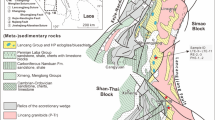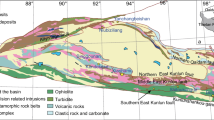Abstract
To suggest the impacts of diapir evolutions on the ore deposits genesis, combined mineralogical, Raman spectrometry and C-, O- and H- isotopes studies of fluid inclusions trapped by their minerals were studied. In diapir zone, the evolution of hydrothermal fluids has been distinguished:
-
type I hot fluids (365 °C) had formation water origin (δD ≈ − 21‰) and moderate salinity (12–23% wt% eq. NaCl) which were trapped by minerals where Mg/Ca ≥ 1, in particular, magnesite and secondary by dolomite 1.
-
later, type II fluids less hot which were divided into two members. The first was the N2-dominant fluids (≈ 250 °C) and more saline (23–43 wt% eq. NaCl and/or KCl) which were trapped in particular by some dolomite 1, dolomite 2 and quartz. The end member was CO2-rich fluids; their trapping temperatures varying from 150 to 270 °C and salinities > 35 wt% eq. NaCl and/or KCl were trapped by minerals where Mg/Ca < 1, in particular in dolomite 2. These type II fluids were of formation water origin (− 52 < δD < − 16‰) which came probably from the dehydration of Triassic materials (mainly gypsum). All CO2 could be previously provided by thermal decomposition of Triassic carbonate. But N2 was of deep origin. The major halokinetic stages that happened at lower Cretaceous period and during the end of Tethysian rifting (associated to basic magmatism) had generated type I and II fluids.
-
the last hydrothermal fluids (type III) derived from organic matter (− 80 < δD < − 65‰). Their temperature and salinity ranges were from 50 to 160 °C and 18.4–23 wt% eq. NaCl, respectively.
The last halokinetic stage occurred during the dominant compressive and transpressive pyrenean and Alpine collision period. The similarities observed between geochemistry characteristics of type III and ore-bearing fluids of some peridiapiric mineralizations implying that only the last hydrothermal events had contributed to the genesis of ore deposits in the diapir zone.








Similar content being viewed by others
References
Angus S, Armstrong B, De Reuck KM (1976) Carbon dioxide. International thermodynamic tables of the fluid states. Pergmon Press, Oxford3
Arnold M, Guillou JJ (1983) Croissance naturelle de paracristaux de quartz dans une saumure sulfatée calcique à basse température. Bull Minéral 106:417–442
Bedir M (1995) Mécanisme, géodynamique des bassins associés aux couloirs de coulissement de la marge atlasique de la Tunisie. Thèse Doctorat d’Etat, Université Tunis II
Bedir M, Boukadi N, Tlig S, Ben Timzel F, Zitouni L, Alouani R, Slimane F, Bobier C, Zargouni F (2001) Subsurface mesozoic basins in the central Atlas of Tunisia: tectonic, sequence deposit distribution and hydrocarbon potentiel. AAPG Bull 85:885–907
Bigeleisen J, Perlman ML, Prosser HC (1952) Conversion of hydrogenic materials to hydrogen for isotopic analysis. Analyt Chem 24:1356–1357
Bolze J, Burrolet PF, Castany G (1952) Le sillon tunisien. In: XIXe Congr géol intern Alger, monogr Région, 2èmesérie, Tunisie, 5
Burrolet PF (1956) Contribution à l’étude stratigraphique de la Tunisie centrale. Ann Mines Géol N 18, Tunis
Charef A, Sheppard SMF (1987) Pb-Zn mineralization associated with diapirism : fluid inclusion and stable isotope (H, C, O) evidence for the origin and evolution of the fluids at Fedj-el-Adoum, Tunisia. Chem Geol 61:113–134
Charef A, Sheppard SMF (1991) The diapir related Bou Grine Pb-Zn deposit (Tunisia): evidence for role of hot sedimentary basin brines. In: Pagel M, Loroy JL (eds) Source, transport and deposition of metals. A.A. Balkema, Rotterdam, pp 269–272
Clayton RN, Mayeda TK (1963) The use of bromine penta-fluoride in the extraction of oxygen from oxides and silicates for isotopic analysis. Geochim Cosmochim Acta 27:43–52
Crampon N (1973) Métamorphisme hydrothermal en faciès salin et pénésalin sur l'exemple du complexe salifère de l'extrême Nord tunisien. Contr Mineral Petrol 39:117–140
Crawford ML (1981) Phase equilibria in aqueous fluid inclusions. In: Short course in fluid inclusions: application to petrology. In: Hollister LS, Crawford ML (eds) Mineralogical Association of Canada, pp 75–100
Darling RS (1991) An extended equation to calculate NaCl contents from final clathrate melting temperatures in H2O–CO2–NaCl fluid inclusions: implications for P–T isochore lacation. Geochim Cosmochim Acta 55:3869–3871
Diamond LW (1992) Stability of CO2 clathrate hydrate + CO2 liquid + CO2 vapor + aqueous KCl–NaCl solution: experimental determination and application to salinity estimates of fluid inclusions. Geochim Cosmochim Acta 56:273–280
Edon M, Ramboz C, Guilhaumou N (1994) Three stage decompression-related. J Mineral 6:855–871
Fertl WH (1976) Abnormal formation pressures in sedimentary basins. Elsevier, New York
Folk KL, Pittman JS (1971) Length slow chalcedony: a new testament for vanished evaporites. J Sediment Petrol 41:1045–1058
Friedman I, O’Neil JR (1977) Compilation of stable isotope fractionation factors of geochemical interest. In: Fleischer M (ed) Data of geochemistry, U.S. geological survey, professional paper 440-KK, p 110
Guilhaumou N, Dhamelincourt P, Touray JC, Touret J (1981) Etude des inclusions fluides du système N2–CO2 des dolomites et quartz de Tunisie septentrionale. Données de la microcryoscopie et de la Microsonde à effet Raman. Geochimica and Cosmochimica Acta 45:657–673
Hemadi H (1987) Les silicates et carbonates authigènes des diapirs du Nord de la Tunisie. Signification chimique et thermique. Thèse d'Université, Orsay, France, p 182
Johnson EL (1992) An assessment of the accuracy of isochore location techniques for H2O–CO2–NaCl fluids at granulite facies pressure–temperature conditions. Geochim Cosmochim Acta 56:295–302
Krooss BM, Leythaeuser D, Lillack H (1993) Nitrogen-rich natural gases. Qualitative and quantitative aspects of natural gas accumulation in reservoirs. Erdöl Kohle-Erdgas Patrochem 46:271–276
Littke R, Kroose B, Idiz E, Frielingsdorf J (1995) Molecular Nitrogen in natural gaz accumulations: generation from sedimentary organic matte rat high temperatures. AAPG 79(3):410–430
Orgeval JJ (1994) Peridiapiric metal concentration : example of the Bou Grine deposit (Tunisian Atlas). In: Boni F (ed) Sediment-Hosted Zn–Pb ores. Special Publication of the Society for Geology Applied to Mineral Deposits, vol 10. Springer-Verlag, Berlin Heidelberg, pp 354–388
Perthuisot V (1972) L’évolution structurale d’un diapir tunisien: le Djebel ech Cheid. Rev Géogr Phys et Géol dynamique XIV, pp 145–152
Perthuisot V (1981) Diapirism in Northern Tunisia. Struct Geol 3:231–235
Perthuisot V (1978) Dynamique et pétrogenèse des extrusions triasiques en Tunisie septentrionale. Thèse d'Etat. Presses de l'Ecole Normale Supérieure, Paris, p 312
Perthuisot V, Guilhaumou N, Touray JC (1978) Les inclusions fluides hypersalines et gazeuses des quartz et dolomites du Trias évaporitique du Nord tunisien. Essai d'interprétation géodynamique. Bull Soc Géol Fr XX, pp 145–155
Perthuisot V, Guilhaumou N (1983) Les diapirs triasiques du domaine Varsovien: phases diapiriques et hydrothermales en domaine périalpin. Bull Soc Géol Fr XXV, pp 397–410
Perthuisot V, Rouvier H (1992) Les diapirs du Maghreb Central et Oriental: des appareils variés, résultats d’une évolution structurale et pétro génétique complexe. Bull Soc Géol Fr 163(6):751–760
Poty B, Leroy J, Jachimowicz L (1976) Un nouvel appareil pour la mesure des températures sous le microscope: l'installation thermométrique Chaixmeca. Bull Soc Fr Minéral crist 99:182–186
Ramboz C, Charef A (1988) Temperature, pressure, burial history and paleohydrology of the les Malines Pb–Zn deposit: reconstruction from aqueous inclusions in barite. Econ Geol 83:784–800
Rosenbaum J, Sheppard SMF (1986) An isotopic study of siderites, dolomites and Ankerites at high temperature. Geochimica Cosmochimica Acta 50:1147–1150
Rouvier H, Perthuisot V, Mansouri A (1985) Pb-Zn deposits and salt-bearing diapirs in southern Europe and North Africa. Econ Geol 80:666–687
Schenk HJ, Horsfield B, Krooss B, Schaefer RG, Schwochan K (1977) Kinetics of patroleum formation and craking. In: Welte DH, Horsfield B, Baker DR (eds) Petroleum and basin evolution, vol 3. Springer, Berlin, pp 233–269
Sheppard SMF, Charef A (1986) Eau organique: caractérisation isotopique et évidence de son rôle dans le gisement Pb-Zn de Fedj-el-Adoum, Tunisie. C R Acad Sci Paris 302(série II):1189–1192
Sheppard SMF, Charef A, Bouhlel S (1996) Diapirism and Zn–Pb mineralization: a general model based on tunisian (N. Africa) and Gulf Coast (U.S.A.) deposits. Soc Econ Geol Spe Publ 6:230–241
Takenouchi S, Kennedy GS (1965) Dissociation pressures of the phase CO2, 5 ¼H2O. J Geology 73:383–390
Willi AB, Tyler BC, Jochen V, Martin R, Thomas P (2014) Assessment of international reference materials for isotope-ratio analysis. IUPAC Techn Rep Pure Appl Chem 86(3):425–467. https://doi.org/10.1515/pac-2013-1023
Author information
Authors and Affiliations
Corresponding author
Additional information
Publisher's Note
Springer Nature remains neutral with regard to jurisdictional claims in published maps and institutional affiliations.
Rights and permissions
About this article
Cite this article
Dermech, M., Charef, A. & Trifi, M. Diagenetic minerals from saline diapirs as thermodynamic, chemical and isotopic tracers of evolution in the North Tunisian sedimentary basin and their impacts on ore deposits genesis. Carbonates Evaporites 35, 113 (2020). https://doi.org/10.1007/s13146-020-00643-z
Accepted:
Published:
DOI: https://doi.org/10.1007/s13146-020-00643-z




